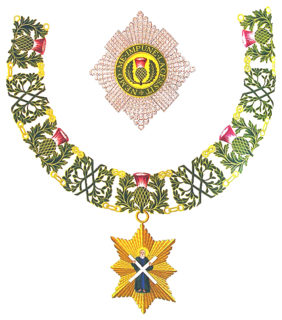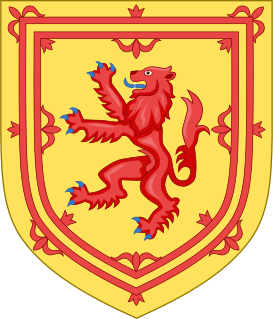The order of precedence in the United Kingdom is the sequential hierarchy for Peers of the Realm, officers of state, senior members of the clergy, holders of the various Orders of Chivalry and other persons in the three legal jurisdictions within the United Kingdom:

The Most Ancient and Most Noble Order of the Thistle is an order of chivalry associated with Scotland. The current version of the Order was founded in 1687 by King James VII of Scotland who asserted that he was reviving an earlier Order. The Order consists of the Sovereign and sixteen Knights and Ladies, as well as certain "extra" knights. The Sovereign alone grants membership of the Order; he or she is not advised by the Government, as occurs with most other Orders.
The order of precedence in Scotland was fixed by Royal Warrant in 1905. Amendments were made by further Warrants in 1912, 1952, 1958, 1999 to coincide with the establishment of the Scottish Parliament and Scottish Government and most recently in 2012.

The Queen's Body Guard for Scotland, The Royal Company of Archers is a ceremonial unit that serves as the Sovereign's bodyguard in Scotland, a role it has performed since 1822 during the reign of King George IV, when the company provided a personal bodyguard to the King on his visit to Scotland. It is currently known as the Queen's Bodyguard for Scotland or, more often and colloquially, The Royal Company. It is located in Edinburgh, the capital city of Scotland. The Royal Company of Archers has a long history in Scotland as a body that celebrated both the recreation and talent of local archers. As a body established by the Monarch, the company has a long history of unique prizes, influential supporters, and ceremonial roles. It has an associated charity, "The Royal Company of Archers Charitable Trust", dedicated to helping disadvantaged individuals with their health and wellbeing in Scotland.
"Highland Laddie", also known as "Hielan' Laddie", is the name of a Scottish popular folk tune "If Thou'lt Play Me Fair Play", but as with many old melodies various sets of words can be sung to it, of which Robert Burns's poem "Highland Laddie" is probably the best known. "If Thou'lt Play Me Fair Play" has been reworked several times since Burns set down his words, Donkey Riding being one variant.
Andrew Douglas Alexander Thomas Bruce, 11th Earl of Elgin and 15th Earl of Kincardine, styled Lord Bruce before 1968, is a Scottish peer and Chief of Clan Bruce.

Thistle is the common name of a group of flowering plants characterised by leaves with sharp prickles on the margins, mostly in the family Asteraceae. Prickles can also occur all over the plant – on the stem and on the flat parts of the leaves. These prickles are an adaptation that protects the plant from being eaten by herbivores. Typically, an involucre with a clasping shape similar to a cup or urn subtends each of a thistle's flowerheads.

Lothian Thistle Hutchison Vale Football Club (LTHV) are a senior non-league football club based in Edinburgh, Scotland. Currently competing in the East of Scotland League Premier Division, they play their home matches at Saughton Enclosure in the Saughton area of the city.

The royal arms of Scotland is the official coat of arms of the King of Scots first adopted in the 12th century. With the Union of the Crowns in 1603, James VI inherited the thrones of England and Ireland and thus his arms in Scotland were now quartered with the arms of England with an additional quarter for Ireland also added. Though the kingdoms of England and Scotland would share the same monarch, the distinction in heraldry used in both kingdoms was maintained. When the kingdoms of Scotland and England were united under the Acts of Union 1707 to form the Kingdom of Great Britain, no single arms were created, thereby maintaining the convention that the royal arms used in Scotland would continue to differ from those used elsewhere.

Richard Walter John Montagu Douglas Scott, 10th Duke of Buccleuch and 12th Duke of Queensberry,, styled as Lord Eskdaill until 1973 and as Earl of Dalkeith from 1973 until 2007, is a Scottish landholder and peer. He is the Duke of Buccleuch and Queensberry, as well as Chief of Clan Scott. He is the heir male of James, Duke of Monmouth, the eldest illegitimate son of King Charles II and his mistress, Lucy Walter.
The Gay Gordons is a Scottish country dance.

The Scottish National War Memorial is located in Edinburgh Castle and commemorates Scottish service personnel and civilians, and those serving with Scottish regiments, who died in the two world wars and subsequent conflicts. Its chief architect was Robert Lorimer, commissioned in 1919, and the monument was formally opened in 1927. It is housed in a redeveloped barrack block in Crown Square, at the heart of the castle, and incorporates numerous monuments.
Thistle is a group of flowering plants.
The Scottish Pipe Band Association of South America (SPBASA), is the pipe band association currently comprising Argentina, Brazil, Chile and Uruguay. It approved its first constitution on December 20, 2003 in Buenos Aires, Argentina; and was officially inaugurated on April 17, 2004 at the First South American Pipe Band Gathering in Montevideo, Uruguay. The comparatively low number of pipe bands and the number of countries encompassed are the principal reasons behind this pipe band association being so unique.
John McIntyre was a Scottish minister and theologian. He was Moderator of the General Assembly of the Church of Scotland 1982/83 and Chaplain to the Queen in Scotland from 1990 to 1996.

The Earl of Erroll is a Scottish highland dance sometimes danced today at Highland games around the world, as part of Scottish National dances repertoire. It is danced to two slow reels, Earl of Erroll and the 23rd Countess of Erroll.

The Thistle Chapel, located in St Giles' Cathedral, Edinburgh, Scotland, is the chapel of the Order of the Thistle.
Dancer's Delight is a Scottish soft-shoe step dance devised in 1964 to commemorate the first anniversary of the United States Highland Dancers' Association. The dance is performed to 2/4 marches, e.g., Scotland the Brave. Dance instructions were published by Ron Wallace in 1994. Unlike softer Scottish ladies' step dances, e.g., The Thistle, Dancer's Delight resembles a Scottish highland dance in terms of style and technique.

Muriel Johnstone is a Scottish pianist and composer. She was raised and schooled in Ardrossan, Ayrshire, Scotland.
The 2019 Scottish Women's Premier League Cup is the 18th edition of the Scottish Women's Premier League's league cup competition, which began in 2002. It is sponsored by the Scottish Building Society and is officially known as the Scottish Building Society Scottish Women's Premier League Cup. The competition is contested by all 16 teams of the two divisions of the Scottish Women's Premier League.